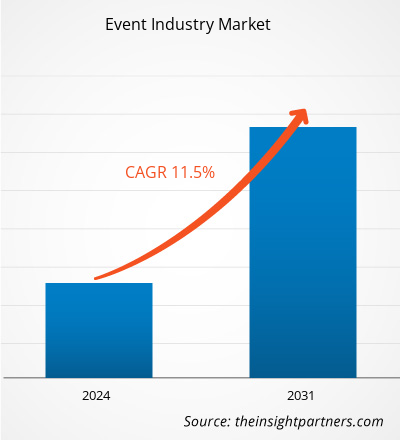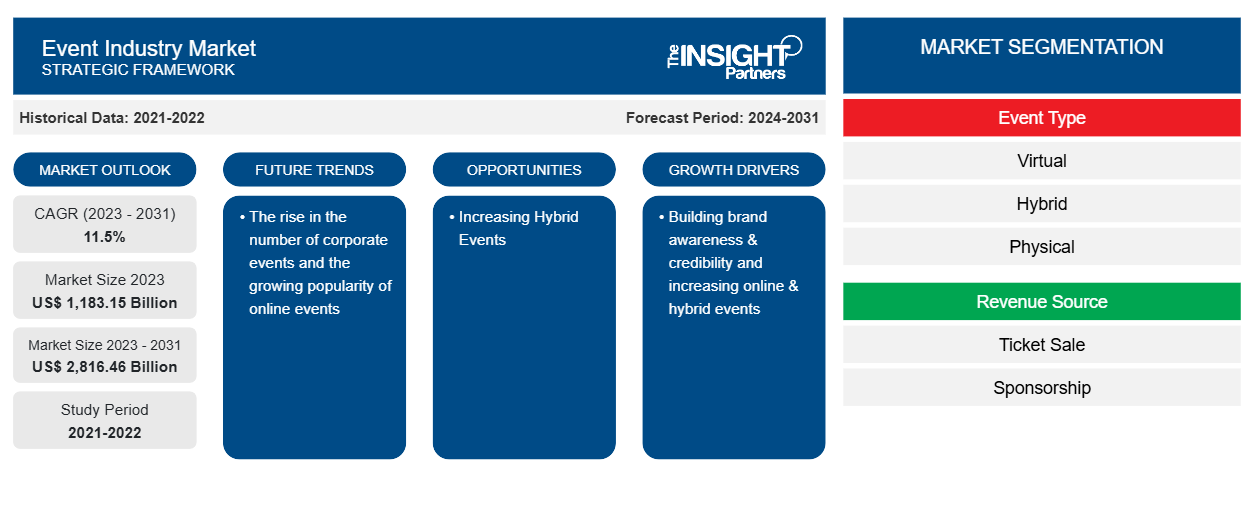Si prevede che il mercato dell'industria degli eventi crescerà da 1.183,15 miliardi di dollari nel 2023 a 2.816,46 miliardi di dollari entro il 2031; si prevede che si espanderà a un CAGR dell'11,5% dal 2023 al 2031. Si prevede che l'aumento del numero di eventi aziendali e la crescente popolarità degli eventi online saranno una tendenza chiave nel mercato.CAGR of 11.5% from 2023 to 2031. The rise in the number of corporate events and the growing popularity of online events are expected to be a key trend in the market.
Analisi di mercato del settore degli eventi
Negli ultimi decenni, il settore della gestione degli eventi è cresciuto fino a diventare un contributo significativo alle economie nazionali. Non solo genera denaro, ma crea anche opportunità di lavoro in settori correlati all'ospitalità, tra cui alloggi, cibo e bevande, servizi congressuali, trasporti, turismo e intrattenimento. La gestione degli eventi è un settore di lunga data all'interno del turismo e dell'ospitalità. Il settore degli eventi a livello globale ha sperimentato una crescita e uno sviluppo significativi negli ultimi anni. Oggi, gli eventi fungono da veicolo di comunicazione di marketing autonomo piuttosto che da sottoinsieme di sforzi pubblicitari. Tutti questi fattori stanno contribuendo alla crescita del settore degli eventi.
Panoramica del mercato del settore degli eventi
La gestione degli eventi implica la pianificazione, l'organizzazione e l'esecuzione di eventi grandi e piccoli in modo professionale ed efficace. Il processo di pianificazione degli eventi include la concettualizzazione, la determinazione della logistica, l'acquisizione di una sede, la negoziazione con i fornitori, la gestione dei fondi, il marketing e la supervisione del processo dall'inizio alla fine. La crescita degli eventi digitali e ibridi, le iniziative di sostenibilità, l'uso dell'intelligenza artificiale per offrire un'esperienza personalizzata nella tecnologia degli eventi sono le nuove tendenze nel settore degli eventi. Si prevede inoltre che l'adozione della realtà virtuale (VR) e della realtà aumentata (AR) aumenterà nel settore degli eventi per offrire ai partecipanti un'esperienza immersiva.personalised experience in event technology are the novel trends in the events industry. Adoption of Virtual Reality (VR) and Augmented Reality (AR) is also expected to boost in events industry to provide participants with an immersive experience.
Personalizza questo report in base alle tue esigenze
Riceverai la personalizzazione gratuita di qualsiasi report, comprese parti di questo report, o analisi a livello nazionale, pacchetto dati Excel, oltre a usufruire di grandi offerte e sconti per start-up e università
-
Scopri le principali tendenze di mercato in questo rapporto.Questo campione GRATUITO includerà analisi di dati che spaziano dalle tendenze di mercato alle stime e alle previsioni.
Driver di mercato e opportunità per il settore degli eventi
Creare consapevolezza e credibilità del marchio per favorire la crescita del mercato
La sponsorizzazione di eventi è un'eccellente opportunità per le aziende di aumentare l'esposizione del loro marchio e ottenere rispetto nel loro settore. Le aziende possono aumentare la loro visibilità a un pubblico pertinente associando il loro marchio a eventi importanti. Le aziende possono esporre efficacemente i loro prodotti o servizi in un ambiente contestualmente pertinente utilizzando il posizionamento del logo, la merce di marca e le sessioni sponsorizzate. Inoltre, la sponsorizzazione di eventi consente alle aziende di allinearsi a cause o valori pertinenti al loro target demografico. Questa associazione può migliorare la percezione del marchio e creare lealtà tra partner, colleghi, clienti e consumatori che condividono valori simili, con conseguente maggiore affinità con il marchio nel tempo. Pertanto, si prevede che il settore degli eventi crescerà a causa della crescente necessità di consapevolezza e credibilità del marchio.
Aumento degli eventi ibridi
Seminari, fiere commerciali, fiere del lavoro, conferenze e altri incontri che combinano componenti in presenza e virtuali sono esempi di eventi ibridi. Sono eventi completamente pianificati che consentono ai partecipanti, sia da remoto che in loco, di interagire e impegnarsi tra loro. Gli eventi ibridi fungono da ponte ideale tra ambienti virtuali e online, dal perfezionamento dei pacchetti di sponsorizzazione all'aumento del ROI. Gli eventi ibridi offrono numerosi vantaggi e, di conseguenza, sono un'eccellente strategia di riduzione dei costi sia per gli organizzatori che per i partecipanti. Pertanto, si prevede che un numero crescente di eventi ibridi creerà opportunità di crescita redditizie per il settore degli eventi durante il periodo di previsione.ROI. Hybrid events offer numerous advantages and, as a result, are an excellent cost-cutting strategy for both organizers and participants. Thus, an increasing number of hybrid events is expected to create lucrative growth opportunities for the event industry during the forecast period.
Analisi della segmentazione del rapporto di mercato del settore degli eventi
I segmenti chiave che hanno contribuito alla derivazione dell'analisi di mercato del settore degli eventi sono la copertura per tipologia di evento, fonte di fatturato, tipo, organizzatore, applicazione e dimensione aziendale.
- In base alla tipologia di evento, il mercato è segmentato in virtuale, ibrido e fisico.
- Gli eventi virtuali forniscono dati dettagliati che vanno oltre la presenza degli ospiti. I dati degli eventi virtuali includono la registrazione all'evento, gli accessi, il traffico di webinar e stand espositivi, analisi delle chat e altri dati di interazione, tutti rappresentati da grafici dettagliati e percettivi.
- In base alla fonte di reddito, il mercato è segmentato in vendita dei biglietti, sponsorizzazioni e altro.
- In base alla tipologia, il mercato è segmentato in concerti musicali, festival, sport, mostre e conferenze, eventi aziendali e seminari e altri.
- In base all'organizzatore, il mercato è segmentato in aziendale, sportivo, educativo, di intrattenimento , associativo e altri,
- In base all'applicazione, il mercato è segmentato in B2B e B2C.
- In base alle dimensioni dell'impresa, il mercato è segmentato in piccole e medie imprese e grandi imprese.
Analisi della quota di mercato del settore degli eventi per area geografica
In base alla regione, il mercato è segmentato in Nord America, Europa, Asia Pacifico, Medio Oriente e Africa, Sud e Centro America.
Gli utenti del Nord America si stanno impegnando da remoto tramite conferenze virtuali tramite piattaforme digitali, indipendentemente dalla loro posizione. I partecipanti da tutto il mondo possono connettersi utilizzando una varietà di strumenti basati sul Web. La comunicazione online e le attività collaborative sono rese possibili dalla convergenza di Realtà Aumentata (AR), Intelligenza Artificiale (AI) e Realtà Virtuale (VR), che possono incorporare tutti gli aspetti di un evento fisico. Inoltre, le organizzazioni stanno rapidamente utilizzando piattaforme di simulazione virtuale per gestire meglio il loro tempo e le loro risorse, il che sta spingendo la crescita del mercato del settore degli eventi in questa regione.VR), which can incorporate all aspects of a physical event. Furthermore, organizations are rapidly utilizing virtual simulation platforms to better manage their time and resources, which is propelling the event industry market growth in this region.
Approfondimenti regionali sul mercato dell'industria degli eventi
Le tendenze regionali e i fattori che influenzano l'Event Industry Market durante il periodo di previsione sono stati ampiamente spiegati dagli analisti di Insight Partners. Questa sezione discute anche i segmenti e la geografia dell'Event Industry Market in Nord America, Europa, Asia Pacifico, Medio Oriente e Africa, e Sud e Centro America.

- Ottieni i dati specifici regionali per il mercato del settore degli eventi
Ambito del rapporto di mercato del settore degli eventi
| Attributo del report | Dettagli |
|---|---|
| Dimensioni del mercato nel 2023 | 1.183,15 miliardi di dollari USA |
| Dimensioni del mercato entro il 2031 | 2.816,46 miliardi di dollari USA |
| CAGR globale (2023-2031) | 11,5% |
| Dati storici | 2021-2022 |
| Periodo di previsione | 2024-2031 |
| Segmenti coperti |
Per tipo di evento
|
| Regioni e Paesi coperti |
America del Nord
|
| Leader di mercato e profili aziendali chiave |
|
Densità degli attori del mercato: comprendere il suo impatto sulle dinamiche aziendali
Il mercato dell'Event Industry Market sta crescendo rapidamente, spinto dalla crescente domanda degli utenti finali dovuta a fattori quali l'evoluzione delle preferenze dei consumatori, i progressi tecnologici e una maggiore consapevolezza dei vantaggi del prodotto. Con l'aumento della domanda, le aziende stanno ampliando le loro offerte, innovando per soddisfare le esigenze dei consumatori e capitalizzando sulle tendenze emergenti, il che alimenta ulteriormente la crescita del mercato.
La densità degli operatori di mercato si riferisce alla distribuzione di aziende o società che operano in un particolare mercato o settore. Indica quanti concorrenti (operatori di mercato) sono presenti in un dato spazio di mercato in relazione alle sue dimensioni o al valore di mercato totale.
Le principali aziende che operano nel mercato dell'industria degli eventi sono:
- Accesso ai servizi di destinazione
- Gruppo di intrattenimento Anschutz
- Società anonima ATPI Ltd.
- Riunioni ed eventi BCD
- Società a responsabilità limitata
- Divertire l'Asia
Disclaimer : le aziende elencate sopra non sono classificate secondo un ordine particolare.

- Ottieni una panoramica dei principali attori del mercato dell'industria degli eventi
Notizie di mercato e sviluppi recenti del settore degli eventi
Il mercato dell'Event Industry viene valutato raccogliendo dati qualitativi e quantitativi dopo la ricerca primaria e secondaria, che include importanti pubblicazioni aziendali, dati associativi e database. Di seguito sono elencati alcuni degli sviluppi nel mercato dell'Event Industry:
- ATPI Group ha annunciato l'acquisizione dell'agenzia di viaggi per il motorsport fondata in Italia FAST. La mossa strategica fa parte dei piani più ampi del Gruppo per espandere e migliorare la propria presenza nel settore dei viaggi sportivi, consentendo al contempo a FAST di rafforzare la propria presenza a livello internazionale. FAST organizza soluzioni di viaggio per importanti eventi sportivi come il World Speed Championship (MotoGP) e il World Superbike Championship, oltre a essere specializzata nei settori dei viaggi d'affari, della produzione televisiva e cinematografica. (Fonte: ATPI Group, comunicato stampa, aprile 2024)
Copertura e risultati del rapporto di mercato del settore degli eventi
Le previsioni di mercato dell'Event Industry sono stimate in base a vari risultati di ricerche secondarie e primarie, come pubblicazioni aziendali chiave, dati di associazioni e database. Il rapporto di mercato "Event Industry Market Size and Forecast (2021–2031)" fornisce un'analisi dettagliata del mercato che copre le seguenti aree:
- Dimensioni e previsioni del mercato del settore degli eventi a livello globale, regionale e nazionale per tutti i segmenti di mercato chiave coperti dall'ambito
- Tendenze del mercato del settore degli eventi, nonché dinamiche di mercato come driver, vincoli e opportunità chiave
- Analisi dettagliata delle cinque forze PEST/Porter e SWOT
- Analisi di mercato del settore degli eventi che copre le principali tendenze del mercato, il quadro globale e regionale, i principali attori, le normative e i recenti sviluppi del mercato
- Analisi del panorama industriale e della concorrenza che copre la concentrazione del mercato, l'analisi della mappa di calore, i principali attori e gli sviluppi recenti nel mercato dell'industria degli eventi
- Profili aziendali dettagliati.
- Analisi storica (2 anni), anno base, previsione (7 anni) con CAGR
- Analisi PEST e SWOT
- Valore/volume delle dimensioni del mercato - Globale, Regionale, Nazionale
- Industria e panorama competitivo
- Set di dati Excel
Report recenti
Testimonianze
Motivo dell'acquisto
- Processo decisionale informato
- Comprensione delle dinamiche di mercato
- Analisi competitiva
- Analisi dei clienti
- Previsioni di mercato
- Mitigazione del rischio
- Pianificazione strategica
- Giustificazione degli investimenti
- Identificazione dei mercati emergenti
- Miglioramento delle strategie di marketing
- Aumento dell'efficienza operativa
- Allineamento alle tendenze normative























 Ottieni un campione gratuito per - Mercato dell'industria degli eventi
Ottieni un campione gratuito per - Mercato dell'industria degli eventi